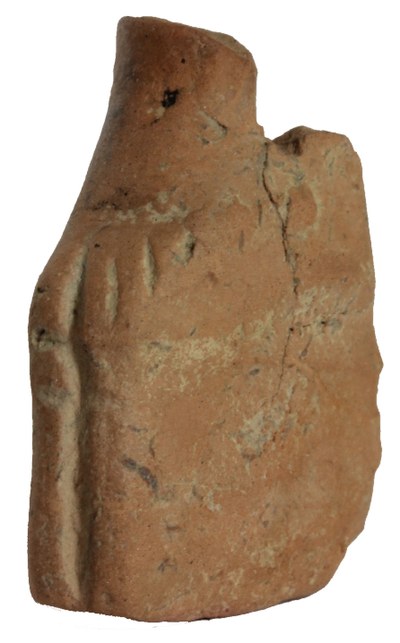Fragment of a sandalled left foot
|
Fragment of a sandalled left foot, Inv. T II-8 Hollow sole, solid foot. Fracture at the ankle joint. Fine vertical crack through the foot to the upper third of the sole. Other minor injuries. Hard light red (10R 6/4-6/5) clay. Traces of sintering. Light brown, 10 YR 6/5. White engobe, no traces of paint. Provenance: Unknown. Dimensions: H: 2,8 cm; W: 1,6 cm; D: 2,0 cm; Height of the sole: 1,2 cm. References: Not published. |
Description: The spherical object is divided into five sectors in the upper half by vertical grooves. At the top in the centre there is an approximately 4 mm hole with a smooth edge in a shallow depression.
Parallels from burial contexts at Myrina suggest that such statuettes were made mainly between the 1st century BC and the 1st century AD[4].
Whether they are goddesses - apart from Aphrodite, Astarte, Atargatis or Isis were thought of, and because of the frequent crescent motif on the headdress also Artemis[5] - priestesses in the cult of the oriental Aphrodite[6] or temple servants[7] is always a subject of discussion. They have also been seen as representations of brides given to the grave of girls who died unmarried[8], or as 'dress-up dolls' consecrated to the gods at the end of childhood. Only, such a refined, exceedingly vulnerable clay figure as the 'Oriental Aphrodite' was not very suitable as a toy[9].
One version of this type is nude. The abdomen has a capped opening concealing a tiny creature, an embryo. The crown of the female is as splendid and projecting as that of the others; the soles are less high. So far, two identical statuettes and one fragment have appeared in this style[10].
As for the sandals with the extremely high soles, they have occasionally been called cothurns[11], but mostly Tyrrhenian (Etruscan) sandals[12]. Both designations are problematic. The actor's kothurn originally had a flat sole and a soft upper that one could comfortably slip into. They were not sandals, but closed, symmetrically cut shoes that alternately fit both feet. The elevation of the sole of the cothurn only began in the Hellenistic period and increased in the Roman imperial period to stilt-like blocks on which one used to walk slowly and measuredly[13].
According to Pollux[14], the soles of Etruscan sandals were square-edged. They were made of wood and had gilded straps. Hesych particularly emphasised their height[15]. In numerous places in Etruria, footwear known as "Tyrrhenika" was found, the sole of which was made of wood and had a metal frame, usually of bronze, and a hinge. The latter connects the two parts of the sole, which are interrupted at the bridge between the front and rear sections[16]. According to the excavation contexts, the pieces date to the 7th and 6th centuries B.C. The sandals of the "oriental Aphrodite"[17] conceived shortly before the birth of Christ are thus already very remote in time from them. Moreover, the soles of the terracotta statuettes are considerably higher than the wooden ones. At most, the lateral triangles or triangular ornaments on the inner and outer edges of the sandals[18], which are recognisable in some statuettes, could allude to a mechanism whose significance as a hinge was no longer properly understood at the time. The delicate Giessen fragment shows no such appliqués.
|
Determination: 1st century BC; from Asia Minor (Myrina?)
|
 |
[1] E. Pottier – S. Reinach, La Nécropole de Myrina (Paris 1887/88) 155. 263; Chr. Bauchhenns, Zwei Terrakotten aus Kleinasien, AA 1973, 5-13; S. Mollard-Besques, Catalogue des figures et reliefrs en terre-cuite grecs et romains II Myrina (Paris 1963) 11-14 pls. 9-11; L. Burn – R. Higgins, Catalogue of Greek Terracottas in the British Museum III (London 2002) 119 f. nos. 2279. 2280 Taf. 50 f.; A. Laumonier, Délos 23, 143-148 pl. 42 f.; E. Schmidt, Katalog der antiken Terrakotten Martin-von-Wagner-Museum der Universität Würzburg (Mainz 1994) 106, no. 157 pls. 30 b. c; W. Schümann, Katalog der antiken Terrakotten im Badischen Landesmuseum Karlsruhe (Göteborg 1989) 116 no. 411 pl. 72.
[2] Laumonier ibid. 144 f. no. 382 pl. 42.
[3] Bauchhenns ibid. 8; Laumonier ibid. 144.
[4] D. Burr, Terra-cottas from Myrina in the Museum of Fine Arts, Boston (Wien 1934) 29-31 pl. 1.
[5] Bauchhenns ibid. 8 note 38.
[6] Burr ibid. 30.
[7] D. Burr Thompson, Troy. The Terracotta Figurines of the Hellenistic Period (Princeton 1963) 89 f.
[8] A. Schwarzmaier, Sitzendes Mädchen im Brautschmuck, in: Pergamon. Panorama der antiken Metropole (Petersberg 2011) 490 f. Kat. 4.3.
[9] K. McK. Elderkin, Jointed Dolls in Antiquity, AJA 34, 1930, 458 f.
[10] V. Dasen, Femmes à tiroir, in: dies. (ed.), Naissance et petite enfance dans L'Antiquité (Friboug – Göttingen 2004) 127-144; E. Simon, Embryu im Schoß der Aphrodite, in: Anodos. Festschr. f. Mária Novotná, TRNVA 2002, 295-299.
[11] Mollard-Besques ibid. 11; J. Sieveking, Die Terrakotten der Sammlung Loeb 2 ((München 1916) 53.
[12] Bauchhenns ibid. 6; Schmidt ibid. 106; E. Simon, Embryo im Schoß der Aphrodite, Anodos. Festschr. Mária Novotná (Trnava 2002) 295.
[13] E. Simon, Das antike Theater (Heidelberg 1972) 23 f.
[14] Onomastikon 7, 92, 7. 93; K. Erbacher, Griechisches Schuhwerk. Diss.Würzburg 1914, 21.
[15] Hesychii Alexandrini Lexicon s. v. Tyrrhenike, Erbacher ibid. 21. 38.
[16] L. Bonfante, Etruscan Dress (Baltimore – London 1975) 59. 203 fig. 140; N. Frankenhauser – J. Weidig, Etruskische Sandalen mit zweiteiligen Sohlen, RM 120, 21014, 13-58 fig. 1. 12.13.
[17] e.g. Schmidt ibid. 106 f. no. 157 pls. 30 b. c.
[18] Bauchhenns ibid. 6. 9 fig. 4; Burn-Higgins ibid. 119 f. no. 2279 pl. 50; Laumonier ibid. 143-148 pl. 42 f.; Schwarzmaier ibid. 490 f. Kat. 4.3.

